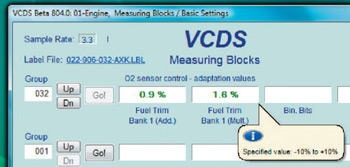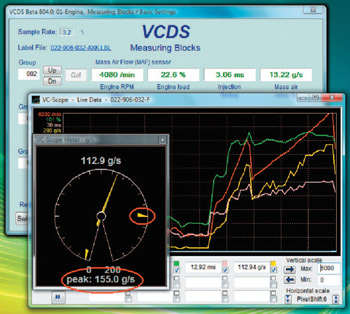One of the most common failures on 2000 and newer Volkswagen and Audi cars is the mass air flow (MAF) sensor, but properly diagnosing such a failure can be problematic. Your customer comes in telling you that his car just doesn’t have the zip it used to have. The car may or may not have fuel trim-related fault codes, most often 17536/P1128. You can’t readily determine that the car is down on power because you have no point of reference, as you haven’t been driving the car. So how do you help your customer?
In all likelihood, your customer is not dreaming. The MAF may be dying a slow death and under-
reporting air flow, but the values it’s reporting are not off enough to trigger a fault code pointing directly at the MAF. VAG repair manuals show specifications for MAF values in grams per second at idle, but checking at idle will rarely reveal a problem.
So, how does one determine that the MAP has failed? The first thing to do is look at the additive and multiplicative fuel trim values. These are almost always found in Measuring Block Group 032. An actual example is shown in Fig. 1. When a MAF is failing, the additive fuel trim will normally be within spec, but the multiplicative trim will be a positive value outside the specifications. Conversely, if additive fuel trim is out of spec, chances are the car has an intake (vacuum) leak rather than a failing MAF. Note that clearing fault codes (even if no fault codes exist) will also reset the fuel trim values to 0, so it is essential to do this check before clearing any fault codes. 
Of course, other factors can also throw off the fuel trims, so before replacing the MAF, it’s a good idea to do a full load test on it. This can easily be accomplished with a tool such as VCDS, which can log, graph and even show peak values during a road test. Check the output of the MAF sensor while doing a full-throttle run in second gear, as shown in Fig. 2. On most current VW/Audi engines, the actual MAF value can be found in Group 002, field 4 or Group 003, field 2. Assuming this test is done at or near sea level, the peak output of the sensor in g/s should be roughly 80% of the rated horsepower of the engine.
For example, if the engine is supposed to produce 200 hp, a healthy MAF is expected to produce a peak value of about 160 g/s. If the number is significantly less than that, you can be almost certain that the MAF is failing.
Exception: If the test is conducted in a location where the altitude is substantially above seal level on a non-turbo engine, an altitude correction factor will need to be applied. If the engine is turbo-charged, you should verify that it is producing the expected amount of manifold pressure (MAP). Requested and actual MAP can usually be found in Group 115 of the measuring blocks.












